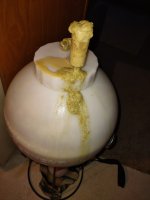Just lay back for a couple of days.
I suspect the OP's August 2013 beer is finished by now.

There is really little volume of CO2 being produced and even the tiniest leak around the lid of a bucket or even the stopper of a carboy will allow the CO2 to leak out.
I'm not sure what you mean by little volume of CO2, but about 1/2 of the weight of the fermented sugars ends up as CO2.
Back of the envelope, just for fun... let's say we have 5 gallons of 1.050 wort made with 44 PPG DME. This would have taken ~5.68 pounds of DME to make, of which ~ 95% (44/46.21) is carbs*. So, ~ 5.4 pounds of carbs.
And let's say we get a final gravity of 1.013, so 74% apparent attenuation. 74% apparent attenuation translates to about 61% real attention (74%/1.22). So the actual sugars fermented would have been about 61% of 5.4 pounds = ~3.3 lbs. Since about half of the fermented sugar becomes CO2, that's about 0.5 x 3.3 lbs = ~1.65 pounds of CO2 produced.
To me, that's significant. In this example, it's equivalent to about a third of a 5lb CO2 tank. Of course, the yeast don't burp that out all at once, which is why we still have "Why is there no airlock activity" threads where the answer turns out to be crappy fermenter seals.
(*I'm ignoring other minor gravity contributors, like proteins.)



